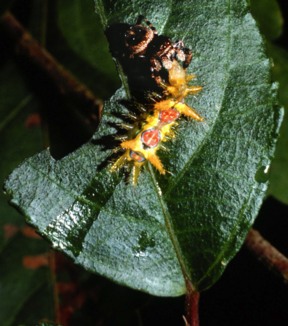Home > Press > Malvern rheometer in continuing search for perfect silk
 |
| Jumping spider devouring tropical caterpillar PHOTO CREDIT: 2007 Oxford Silk Group |
Abstract:
In work published in the journal Polymer (June 2007) Oxford researchers have taken an important step towards understanding why it has been impossible to artificially spin protein fibres with the superb material properties of their natural models, the silks of spiders and silkworms.
Malvern rheometer in continuing search for perfect silk
Malvern, UK | Posted on June 7th, 2007Using a Bohlin Gemini HR Nano rheometer from Malvern Instruments, Chris Holland and Professor Fritz Vollrath, together with Dr Ann Terry and Dr David Porter, took unspun natural silk dope and compared it to artificial silk dope under shear forces similar to those encountered in a natural spinning duct. Optimized for the control of ultra-low torques, the Gemini HR nano is ideal for probing sensitive material structures and allowing measurement of low volume samples. The research group discovered fundamental differences in kind, not just in degree, between the natural and artificial silk dopes.
This research builds on previous work by the Oxford group, which demonstrated that the flow characteristics of native spider and silkworm dopes are very similar despite the independent evolution of the two silks. Such convergence of the two distinct materials towards an identical flow behaviour strongly suggests that dope rheology is a key to the production of high-performance protein fibres
Native silk dope taken straight from the gland can easily be drawn into strong fibres, but the fibres from artificial dope cannot be spun into any type of serious filament without unnatural treatment using strong chemicals. Clearly, native silk dopes have the innate ability to form into a fibre, which is lost in translation when attempting to create artificial silk dope. Discovering the mechanisms behind this seemingly effortless process will be a crucial step towards the biomimetic spinning of artificial silk fibres using the animal's own technology. For further details of the research work visit:
http://www.admin.ox.ac.uk/po/070601a.shtml and http://www.oxfordsilkgroup.com
Research paper reference: Holland, C., Terry, A.E., Porter, D. & Vollrath .F. Natural and Unnatural Silks. Polymer 48, 3388 - 3392 (2007)
Author contact: Chris Holland (University of Oxford, UK) Tel: +44 1865 271216; E-mail
####
About Malvern Instruments
Malvern Instruments is a global company that develops, manufactures and markets advanced analytical systems used in characterizing a wide variety of materials, from bulk powders to the latest nanomaterials and delicate macromolecules. Innovative technologies and powerful software produce systems that deliver industrially relevant data enabling customers to make the connection between micro (eg particle size) and macro (bulk) material properties (rheology) and chemical composition (chemical imaging). Malvern laboratory, on-line and in-line solutions are proven in sectors from cement to pharmaceuticals and support the understanding, improvement and optimization of many industrial processes.
Headquartered in Malvern, UK, the company has subsidiary organizations in all major European markets, North America, China, Korea and Japan, key partnerships in India, a global distributor network and a number of applications laboratories around the world.
For more information, please click here
Contacts:
Trish Appleton
Kapler Communications
Suite 2, Cressner House
12 Huntingdon Street
St Neots, Cambs PE19 1BD UK
Tel: +44 (0) 1480 471117
Fax: +44 (0) 1480 471118
USA contact:
Marisa Fraser
Malvern Instruments Inc
10 Southville Road
Southborough, MA 01772, USA
Tel: +1 508 480 0200
Fax: +1 508 460 9692
Please send sales enquiries to:
Alison Vines
Malvern Instruments Ltd
Enigma Business Park, Grovewood Road
Malvern, Worcestershire WR14 1XZ UK
Tel: +44 (0) 1684 892456
Fax: +44 (0) 1684 892789
Copyright © Malvern Instruments
If you have a comment, please Contact us.Issuers of news releases, not 7th Wave, Inc. or Nanotechnology Now, are solely responsible for the accuracy of the content.
| Related News Press |
Materials/Metamaterials/Magnetoresistance
![]() First real-time observation of two-dimensional melting process: Researchers at Mainz University unveil new insights into magnetic vortex structures August 8th, 2025
First real-time observation of two-dimensional melting process: Researchers at Mainz University unveil new insights into magnetic vortex structures August 8th, 2025
![]() Researchers unveil a groundbreaking clay-based solution to capture carbon dioxide and combat climate change June 6th, 2025
Researchers unveil a groundbreaking clay-based solution to capture carbon dioxide and combat climate change June 6th, 2025
![]() A 1960s idea inspires NBI researchers to study hitherto inaccessible quantum states June 6th, 2025
A 1960s idea inspires NBI researchers to study hitherto inaccessible quantum states June 6th, 2025
![]() Institute for Nanoscience hosts annual proposal planning meeting May 16th, 2025
Institute for Nanoscience hosts annual proposal planning meeting May 16th, 2025
Announcements
![]() Rice membrane extracts lithium from brines with greater speed, less waste October 3rd, 2025
Rice membrane extracts lithium from brines with greater speed, less waste October 3rd, 2025
![]() Researchers develop molecular qubits that communicate at telecom frequencies October 3rd, 2025
Researchers develop molecular qubits that communicate at telecom frequencies October 3rd, 2025
![]() Next-generation quantum communication October 3rd, 2025
Next-generation quantum communication October 3rd, 2025
![]() "Nanoreactor" cage uses visible light for catalytic and ultra-selective cross-cycloadditions October 3rd, 2025
"Nanoreactor" cage uses visible light for catalytic and ultra-selective cross-cycloadditions October 3rd, 2025
Tools
![]() Japan launches fully domestically produced quantum computer: Expo visitors to experience quantum computing firsthand August 8th, 2025
Japan launches fully domestically produced quantum computer: Expo visitors to experience quantum computing firsthand August 8th, 2025
![]() Rice researchers harness gravity to create low-cost device for rapid cell analysis February 28th, 2025
Rice researchers harness gravity to create low-cost device for rapid cell analysis February 28th, 2025
|
|
||
|
|
||
| The latest news from around the world, FREE | ||
|
|
||
|
|
||
| Premium Products | ||
|
|
||
|
Only the news you want to read!
Learn More |
||
|
|
||
|
Full-service, expert consulting
Learn More |
||
|
|
||








